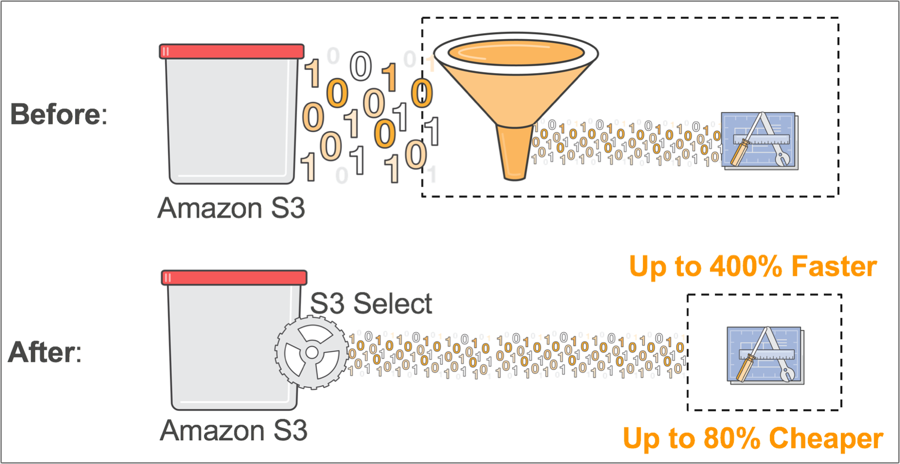The Amazon S3 service has received several new updates to its service: a new storage class, S3 One Zone-Infrequent Access (Z-IA), and the general availability (GA) of the previously announced S3 Select capability. The new Z-IA storage class is a low-cost option for storing and retrieving infrequently used data with limited durability requirements, and S3 Select allows customers to retrieve a subset of S3 stored data faster using a SQL like syntax that is exectured remotely within the service.
Jeff Barr, chief evangelist for AWS, wrote in a recent AWS blog post about the new updates, which evolve around storing and retrieving data in Amazon Simple Storage Service (S3). The now generally available S3 Select is a new Amazon S3 capability enabling customers to pull out only the data they need from an object using a standard SQL expression, with the benefit of having an increase in performance and lower costs. S3 Select is available in all AWS regions, and customers can use the service from the AWS SDK for Java, AWS SDK for Python, and AWS CLI. The pricing for this service is based on the data scanned, and the data returned.

Image Source: https://aws.amazon.com/blogs/aws/s3-glacier-select/The new S3 Z-IA class is a less expensive class than the existing Standard-IA storage class. S3 Z-IA is the inexpensive option for customers to store data that they do not need frequently. Objects are stored in a single AWS Availability Zone (AZ) with almost a hundred percent of durability, as with all the other S3 classes. However, it is not resilient to the physical loss of an AZ resulting from disasters, such as earth quakes and floods.
The AWS documentation recommends the following when choosing which Infequently Accessed (IA) storage class to use:
- Standard IA—Use for the primary or only copy of data that can't be recreated.
- One Zone AI—Use if the data can be recreated if the Availability Zone fails, and for object replicas when setting cross-region replication (CRR).
With the One Zone IA class the options for storing data increase to AWS customers. Based on the requirement for either availability, retention, size, latency, or costs, customers can choose the appropriate S3 Storage class. Mai-Lan Tomsen Bukovec, vice president, Amazon S3, AWS, said in a business wire article:
We offer other storage tiers, like Amazon S3 Standard-IA, for highly durable storage of infrequently accessed objects, and Amazon Glacier for highly durable archive storage, because we know customers have different needs for different data. Amazon S3 Z-IA is ideal for customers who want storage for infrequently accessed objects, don't need the durability of multiple Availability Zones, and want to save cost with our lowest priced storage tier in Amazon S3.

Image source: https://www.cloudberrylab.com/blog/amazon-s3-storage-classes-explained/
There is a definite reaction from customers towards the availability of S3 Z-IA. Shutterfly, Inc., for instance, a leading online retailer and manufacturer of high-quality personalized products and services, leverages S3 and welcomes the S3 Z-IA. Their CTO and senior vice president, Satish Menon, said in the same business wire article:
As we increasingly use AWS to manage billions of customer photos, Shutterfly is benefiting from multiple tiers of AWS storage offering high durability, availability, and security. We’re excited about S3 Z-IA, which will allow us to be operationally efficient while protecting our customers' photos.
Both new updates increase the value and flexibility the S3 Cloud Object storage offers for its customers.